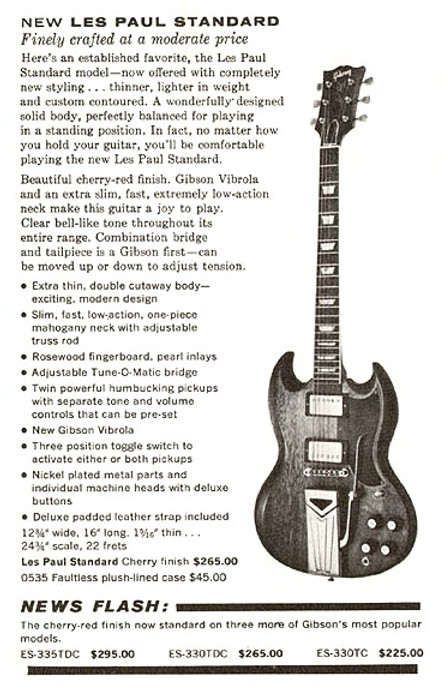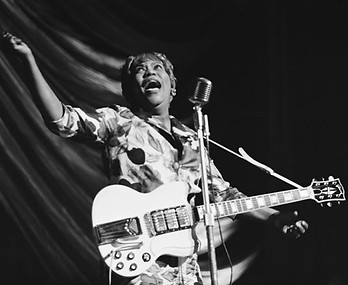Sia's Vintage Guitars
Tokai
Tokai TSG 60 CH

Homage to the Gibson SG Standard
The Gibson Solid Body (SG) was introduced at the 1961 NAMM show as a replacement for the classic single cutaway Les Paul (LP) design. For its first two years of production, however, it was referred to as the "Les Paul" and it only took on the SG name from 1963. LP sales were in decline towards the late '50s, and the company wanted to give the model a full makeover and turn it into something more aggressive and resonant with modern players of the time. This was the aim behind the SG's characteristic slimmer and lighter body, bevelled edges, double cutaway allowing access to the highest frets, and pair of sharp horns that gave it a distinctive and edgy look.

1961 Gibson Catalogue
Pic Credit: vintageguitarandbass.com
In the 1960s, Gibson offered a few different types of SG guitars - most notably, the SG Standard, the SG Special, the SG Junior, and the SG Custom.
-
SG Standard: This was the template model for the SG series, and was designed to replace the Les Paul Standard. It featured a solid mahogany body and neck, two humbucking pickups, and a bound rosewood fingerboard.
-
SG Special: The SG Special was a more affordable option for players who wanted the classic SG look and feel, but without the high price tag. It featured a solid mahogany body and two P-90 pickup.
-
SG Junior: The SG Junior was a more stripped-down version of the SG, designed for budget-conscious players. It had a smaller, solid mahogany body and a single P-90 pickup.
-
SG Custom: The SG Custom was the highest-end version of the SG, designed for professional players. It featured a solid mahogany body and neck, bound fingerboard and headstock, gold hardware, and multi-ply binding.


1966 Gibson Catalogue
Pic Credit: vintageguitarandbass.com
Initially, there weren’t many famous guitarists that used the SG. Sister Rosetta Tharpe was the exception. But eventually, it passed through the hands of legends such as Jimi Hendrix, Eric Clapton, and most popularly, Angus Young of AC/DC.



Sister Rosetta Tharpe
Pic Credit: guitar.com
Jimi Hendrix
Pic Credit: Gibson Brands México (Pintrest)
Angus Young of AC/DC
Pic Credit: guitar.com
The Tokai "TSG Refine Model"
A review of the TSG 60 CH in 1985 said, "Copying a Gibson is a different task altogether. Fenders (not to disparage them in any way, of course) were designed from the start to be mass produced. Their bolt-on necks and simple bodies, rudimentary hardware and machine-easy shaping made them inevitable targets for a mass production orientated nation to whom originality in guitar design came about as naturally as walking does to a fish. It was the natural starting point for a whole host of Japanese makers to begin with in their climb up from obscurity.Inevitably, though, Tokai have turned their gaze on Gibson. Now we're seeing Tokai 335 simulacra, Explorer dupes, Les Paul types, and even S.G. lookalikes in the shops, all bearing the Tokai name and aiming to prove that they can get as close to an original Gibson as they can a Fender" (Gary Cooper, InTune magazine, 1985). As a novice guitar builder myself, I can testify to the fact that making a set neck with an angled headstock (like on the TSG) is far more difficult than a bolt-on neck. The precision required with the neck angling and scarf jointing at the headstock add great complexity to the build.
The first catalogue in which I have found the TSG featured is from 1984. Two models were introduced - the TSG 50 and TSG 60. The former was inspired by the 1976 Gibson SG while the latter was inspired by the 1963 Gibson SG. Both were positioned as "REFINE" models. The TSGs have featured in Tokai catalogues ever since.


1983 Tokai Catalogue
Pic Credit: yokochou.com
This article focuses on a guitar I recently acquired - the Tokai TSG 60. I love doing research on these vintage instruments, and so here is a synthesis of information from all the catalogues and websites I could access...
Dating

The serial number on my guitar dates it to 1983 production, and the first catalogue to feature the TSG was in 1983. However, it seems that models with 1982 production dates exist too which means that production might have started in 1982 while marketing and distribution began in 1983.
Price

The TSG 60 was priced at ¥60,000 in the 1984 catalogue, which was about USD $250 at the time or approximately USD $750 in 2023. For perspective, this price point placed the model somewhere in the lower-middle end of the catalogue with the most expensive guitar being ¥200,000 and the least expensive being ¥38,000. The TSG 60 was the most expensive in the SG model line up, with the other option being the TSG 50 at ¥50,000.
Wood

The 1984 catalogue explains the the SG 60 was made of mahogany, true to the original Gibson. The guitar is very light 3.05 kgs or 6.75 lbs, surely due to its distinctly thin body. Also, the body of my TSG 60 is made from two pieces of wood.
Bridge

The TSG 60 has the "Tune-o-matic" style bridge, correct to the 1963 Gibson SG that it is playing homage to. More specifically, it has the ABR-1 type bridge that is period correct for the model it is inspired by.
Headstock & Tuners


The TSG 60 has "deluxe" tuners with vintage tulip-style tuning pegs, similar to the original Kluson tuners that Gibson used. Also, the headstock has the flower pot mother-of-pearl inlay like the original. The "Tokai" logo is mother-of-pearl inlay too. The headstock is angled at about 17 degrees - similar to its Gibson counterpart from the early 1960s. I can't be certain if the headstock is scarf jointed or not. However, there is no volute on the backside of the headstock where it would have jointed to the neck.
Neck & Fretboard


The neck is made of mahogany, with a rosewood fretboard. The fretboard has ivory coloured celluloid binding to give it a vintage look. The binding goes over the fret nibs, which provides for exceptional aesthetics and playing comfort, and is a rather laborious and difficult job for the craftsman. It has a beautiful 60s shaped neck profile, with a 24.75 inch scale, with 22 large (not narrow vintage style) frets. Also, it is a set neck, not a bolt on - true to the original. And the neck joins he body at around the 20th fret just like the 1963 Type 1 SG that it is paying homage to (unlike joint at 18 fret like 50).
The fretboard has a radius close to 12", as one might expect of an SG-style model. However, this is interesting for Tokai, because my other non-Strat models like the Star-shaped FSD or V-shaped FV both have 7.25" radiuses even though the models they were inspired by surely had flatter fretboards.
The TSDG 60 has "crown" shape inlay starting at the 3rd fret, just like the original Gibson SG Standard it is paying homage to. This is distinctly different from the "block" shape inlay starting at 1st fret on the TSG 50. The inlay material looks like plastic, while I assume it was mother of pearl on the original Gibson.
Trussrod

The truss rod access is hidden under a truss rod cover located at the headstock. The rod requires a size 8 Gibson style wrench.
Colour

Two colours were available at the time my guitar was made - Olympic White (OW) and Cherry (CH). Mine is the latter, and has maintained its vibrancy even after 40 years! The finish seems to be poly, based on an alcohol swab test I did. Catalogues later in the 80s present more colour options for the SG, including Walnut Red (WR) and Black (BB).
Pickups

I have to say, the pickups are really incredible! My guitar has the higher end '57 PAF Vintage' humbucker pickups, as advertised in the 1984 catalog. These were the same pickups used on the highest end TES 200 model (replica of Gibson ES) that was the most expensive vintage-based guitar on the 1984 catalogue at 200,000 Yen. The PAFs were phased out of the TSG 60 in the late '80s, and both models were advertised with the MKII pickups from the 1987 catalogue onwards.
The neck presents 8.75 ohms and the bridge presents 8.7 ohms. The pickups are warm and hot and easily push my small tube amp into overdrive. They are very distinct from the humbuckers in my FV and FSD models!
Control Knobs & Switch

A toggle switch with three positions allows you to choose betwen neck, bridge, and both pickups. There are two volume and to tone knobs.
Nut

The nut looks and feels like bone. It holds the guitar in tune very well.
Pickguard

The TSG 60 has a black and white five-ply pick-guard that is a replica of the 1963 Standard SG. The pic guard is the period-correct large version that goes all the way up to the start of the fretboard.